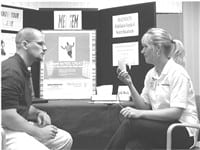Body Of Evidence New Device Makes It Easier To Assess — And Reach — Fitness And Rehab Goals
Losing weight and getting fit are generally the result of balancing the correct amount of exercise with proper calorie intake.
However, an individual’s metabolism can be a tricky factor in determining that balance.
A newly FDA-approved technology now being used at HealthSouth Rehabilitation Hospital of Western Mass. is answering the metabolism question and making it easier for people to reach their physical goals.
MedGem, a hand-held device produced by a company known as Healthe-Tech, quickly and accurately measures a person’s resting metabolic rate (RMR), which is simply how many calories the body burns while at rest, said Tricia O’Brien, a dietician at the facility.
“Once you have that information, you know how many calories you can take in combined with how much exercise you will need to lose weight and reach your fitness goals,” she explained.
And reaching goals is what effective rehabilitation is all about.
The Metabolic Question
Metabolism has become a watchword of sorts in the fields of fitness and rehabilitation, although many people don’t understand its importance in weight management — and, therefore, in the prevention of weight-related risk factors such as heart disease, diabetes, and hypertension.
Simply put, metabolism is the body’s process of converting food into energy to keep itself running. The body produces energy by using oxygen to break down carbohydrates, fats, and proteins. A person’s total metabolism represents the number of calories needed for maintaining body functions, daily activity, and the energy spent exercising.
The resting metabolic rate represents the number of calories the body burns to maintain vital body functions such as heart rate, brain function, and breathing. In other words, the number indicates the calories a person would burn if awake, but resting, all day. For most people, RMR represents up to 75{06cf2b9696b159f874511d23dbc893eb1ac83014175ed30550cfff22781411e5} of total metabolism, but for those whose activity is limited, such as patients in acute care or in therapy, that percentage can be around 100{06cf2b9696b159f874511d23dbc893eb1ac83014175ed30550cfff22781411e5}.
Weight management is largely knowing how to balance caloric intake with calories burned. And, according to a study published in the journal Metabolism, overestimating or underestimating RMR can result in an error of almost 900 calories a day, which can add up to a pound a week. Metabolism may also change over time due to weight loss, strength training, illness, or other factors.
Knowing one’s RMR can lead to tremendous health benefits, said Monica LeBlanc, a registered nurse and Health-South’s education coordinator.
“Obesity is a serious health problem in our country,” she said. “If you know your RMR, you can be more proactive in reducing risks related to obesity such as cardiovascular disease and diabetes. By balancing your caloric intake with expenditure, you can learn how to manage your weight or achieve your optimal fitness level”
A New Test
The MedGem method involves breathing into the hand-held device for approximately 10 minutes. The test is ideally performed 10 to 12 hours after eating or exercise. In the test, the amount of oxygen consumed by the user is measured and then used to determine the person’s RMR.
“Metabolism varies from person to person and is influenced by such factors as body composition, weight, age, and gender,” O’Brien said. “Medications, stress, smoking, and other factors can also affect RMR, so the only accurate way to know yours is to have it measured.”
At HealthSouth, once patients determine their RMR, they can use a software package called BalanceLog to track their personal nutrition and weight management program. MedGem is also equipped to manage conditions such as diabetes, chronic obstructive pulmonary disease, burns, and liver disease.
The BalanceLog is adaptable to personal digital assistants, personal computers, and the Internet, and includes a database of 300 exercises and more than 3,000 foods, as well as tracking 13 nutrients as part of a daily fitness plan.
The program also supports nutritional programs recommended by the American Heart Association and the U.S. Department of Agriculture.
“After you plug in your RMR, each day you can record what you’ve eaten, exercise you’ve done, and your other activities,” O’Brien explained. “Then it calculates how many more calories you should eat and burn to meet your daily budget.”
Thanks to yet another medical advance in the computer age, people seeking fitness and rehabilitation aren’t only working toward goals — they’re working toward the correct ones.



Comments are closed.